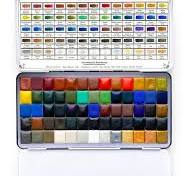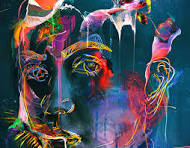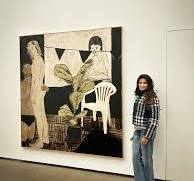The Timeless Beauty of Watercolors
Watercolor painting is a captivating art form that has stood the test of time, captivating artists and art enthusiasts alike with its ethereal beauty and unique characteristics. The delicate translucency and fluidity of watercolors create a magical quality that sets them apart from other mediums.
A Symphony of Colors
Watercolors offer a wide range of vibrant hues and subtle tones that can be blended and layered to create stunning visual effects. From soft pastels to bold primaries, the versatility of watercolors allows artists to express a myriad of emotions and moods on paper.
The Magic of Transparency
One of the most enchanting aspects of watercolors is their transparency. When applied in thin washes, watercolors allow light to pass through the layers, creating luminous effects that give the paintings a sense of depth and luminosity. This transparency adds a dreamlike quality to watercolor artworks, making them truly mesmerizing.
Expressive and Versatile
Watercolors can be used in various techniques, such as wet-on-wet, wet-on-dry, dry brushing, and lifting, giving artists endless possibilities for creative expression. Whether creating landscapes, portraits, still life compositions, or abstract works, watercolors offer a unique way to capture the beauty of the world around us.
A Timeless Tradition
The history of watercolor painting dates back centuries, with artists throughout the ages using this medium to create masterpieces that have stood the test of time. From the delicate botanical illustrations of the Renaissance to the vibrant landscapes of the Impressionists, watercolors have left an indelible mark on art history.
Whether you are an experienced artist or just starting your creative journey, exploring the world of watercolors can be a rewarding experience. Embrace the magic of this timeless medium and let your imagination soar on waves of color and light.
Essential Watercolor FAQs: Materials, Techniques, and Preservation Tips for Beginners
- What materials do I need to start watercolor painting?
- How do I create smooth washes with watercolors?
- What techniques can I use to add texture to my watercolor paintings?
- How do I prevent my watercolor paper from warping or buckling?
- What are some common mistakes to avoid when painting with watercolors?
- How can I mix colors effectively with watercolors?
- What is the best way to preserve and protect finished watercolor paintings?
What materials do I need to start watercolor painting?
One frequently asked question by beginners interested in watercolor painting is, “What materials do I need to start watercolor painting?” To embark on your watercolor journey, essential materials include high-quality watercolor paints, brushes of various sizes for different techniques, watercolor paper or a sketchbook specifically designed for wet media, a palette for mixing colors, and a container for water. Additionally, masking tape or fluid can be handy for creating crisp edges, while a pencil and eraser are useful for sketching outlines before painting. Investing in good quality materials can enhance your painting experience and help you unleash your creativity with this captivating medium.
How do I create smooth washes with watercolors?
To create smooth washes with watercolors, it is essential to start with the right consistency of paint and water. Begin by mixing your desired color with water on a palette to achieve a smooth and even consistency. Next, wet the paper evenly with clean water before applying the paint, ensuring that the surface is damp but not overly wet. Using a large brush, apply the diluted paint in long, even strokes, working quickly to prevent drying lines or streaks. Tilt the paper slightly to allow gravity to help create a smooth flow of color. Practice and patience are key to mastering the technique of creating seamless washes that add depth and richness to your watercolor artworks.
What techniques can I use to add texture to my watercolor paintings?
Adding texture to watercolor paintings can enhance the visual interest and tactile quality of your artwork. There are several techniques you can use to achieve different textural effects in watercolors. One common method is salt sprinkling, where you sprinkle salt onto wet paint to create a granulated texture as the salt absorbs the water. Another technique is using masking fluid to preserve areas of white paper and create sharp, defined textures once removed. You can also experiment with dry brush strokes, lifting off paint with a damp brush or sponge, or even incorporating mixed media elements like collage to add depth and dimension to your watercolor compositions. By exploring these techniques and combining them creatively, you can elevate your watercolor paintings with captivating textures that engage both the eyes and the fingertips.
How do I prevent my watercolor paper from warping or buckling?
To prevent watercolor paper from warping or buckling, it is essential to use the right techniques and materials. Stretching the paper before painting can help minimize warping by ensuring that the paper remains taut as it dries. This can be done by soaking the paper in water and then securing it to a flat surface using tape or staples until it dries completely. Additionally, using thicker watercolor paper or stretching blocks designed specifically for watercolors can also help prevent buckling. Working with less water or using a hairdryer to dry layers between washes can further reduce the risk of warping, allowing artists to create smooth and flat watercolor paintings.
What are some common mistakes to avoid when painting with watercolors?
When painting with watercolors, there are several common mistakes that artists should be mindful of to achieve successful results. One common mistake is using too much water, which can lead to colors bleeding uncontrollably and losing their vibrancy. It’s important to find the right balance between water and pigment to maintain control over the painting process. Another mistake to avoid is not layering colors properly, as this can result in muddy or dull hues. By allowing each layer to dry before adding more color, artists can create depth and intensity in their watercolor artworks. Additionally, neglecting to plan the composition and failing to use quality paper can also hinder the outcome of a watercolor painting. By being aware of these common pitfalls and practicing good technique, artists can enhance their skills and create captivating watercolor masterpieces.
How can I mix colors effectively with watercolors?
To mix colors effectively with watercolors, start by understanding the color wheel and how different hues interact with each other. Begin with primary colors (red, blue, yellow) and experiment with mixing them to create secondary colors (orange, green, purple). Gradually introduce complementary colors (opposites on the color wheel) to create vibrant contrasts or mix analogous colors (neighbors on the color wheel) for harmonious blends. Remember to control the amount of water in your brush to achieve the desired consistency and transparency of the mixed colors. Practice blending techniques such as wet-on-wet or layering to create subtle gradients and depth in your artwork. By mastering color mixing techniques and experimenting with various combinations, you can unlock the full potential of watercolors and bring your artistic vision to life on paper.
What is the best way to preserve and protect finished watercolor paintings?
When it comes to preserving and protecting finished watercolor paintings, there are several key steps that artists can take to ensure the longevity and beauty of their artworks. One effective method is to frame the painting under UV-protective glass to shield it from harmful light exposure, which can cause fading over time. Additionally, storing the artwork in a cool, dry place away from direct sunlight and fluctuations in temperature and humidity can help prevent damage such as warping or discoloration. Applying a fixative spray or varnish specifically designed for watercolors can also provide a protective barrier against dust, moisture, and other environmental elements, extending the life of the painting for years to come.




